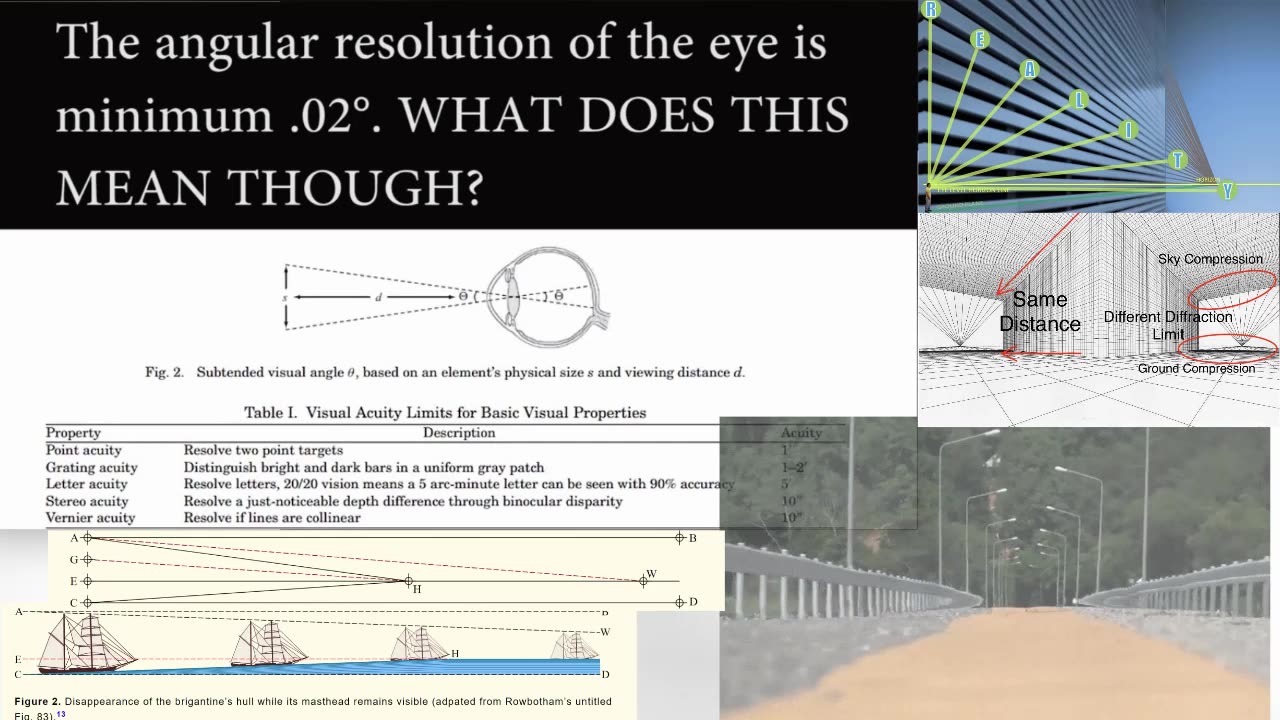Premium Only Content

Why do things disappear bottom up?
Why do things disappear bottom up?
https://publish.obsidian.md/shanesql/Bottom+up+obstruction+on+a+level+plane
The mainstream explanation for bottom-up obstruction is that it is EXPLICITY and SOLEY caused by the geometric curvature of the Earth. However, this effect can be entirely explained by optical phenomena related to angular resolution and perspective. The loss of information at the horizon can be modeled using the values of optical limits of perception, challenging the notion that it is due to physical curvature. If this is even PARTLY the case, why in the world would no calculation take into account real world, quantifiable phenomena such as angular resolution limits when 'calculating' curvature?
Why do objects appear to disappear from the bottom up as they move away from an observer on a level plane? This visual phenomenon can be attributed to the principles of perspective, angular resolution, and optical effects rather than the curvature of the Earth. Let's delve into these concepts to understand how they contribute to this effect.
Angular resolution refers to the smallest angle at which two points can be distinguished as separate by the human eye. This limit plays a crucial role in how we perceive distant objects. When an observer's height is lowered, the horizon line appears closer, affecting the compression and expansion of angles in the field of view. The loss of information is thus a function of angular resolution and perspective, not curvature.
The angular resolution limit of the human eye is approximately between 0.02° and 0.03°. When the angular size of an object is smaller than this limit, optical information loss occurs, causing the object to disappear from sight. This is particularly evident when observing objects at a distance, where the lower parts of the objects disappear first due to the compression of angles near the ground.
The relationship between the observer's height and the horizon line is proportional. As the observer's height decreases, the angles near the ground compress, making the horizon appear closer. Conversely, angles above the eyeline expand. This compression of angles at the bottom and expansion at the top alters how objects are visually processed, leading to the bottom-up disappearance of objects as they move away.
Atmospheric conditions, such as refraction and aberrations, also play a role in altering the perceived size and shape of distant objects. These optical phenomena can cause objects to appear distorted or to disappear at certain angles, contributing to the bottom-up obstruction effect.
The bottom-up disappearance of objects on a level plane is a complex interplay of perspective, angular resolution, and optical phenomena. By understanding these principles, it can be determined that this effect is not necessarily indicative of Earth's curvature but rather a result of how our eyes and the atmosphere interact with light. ....Perhaps we should reconsider the assumptions about the nature of our
-
 3:36
3:36
Anti-Disinfo League
7 days agoWho do you you think runs NASA?
315 -
 LIVE
LIVE
GrimmHollywood
14 hours ago🔴LIVE • GRIMM HOLLYWOOD • GRIMM STRANDING 2 • DAY 4 • STREAM DON'T END TIL I BEAT DEATH STRANDING 2
87 watching -

RG_GerkClan
2 hours ago🔴LIVE - Dynamic Duo w/ Father Z! Lets Dominate this Weekend - Escape From Tarkov - Gerk Clan
1052 -
 8:12
8:12
Game On!
14 hours ago $6.92 earnedMy PERFECT Solution for the NCAA March Madness Expansion!
37.3K5 -
 31:45
31:45
RepublicanStudy
20 hours agoOne Big Beautiful Exclusive Conversation with Budget Chairman Arrington
27.5K7 -
 8:28
8:28
MattMorseTV
19 hours ago $15.73 earnedThe EU just SURRENDERED to Trump.
77.6K53 -
 2:09:17
2:09:17
Side Scrollers Podcast
1 day agoKirsche & Leaflit on HIT LIST + Nintendo RUINS Mario Kart + More | Side Scrollers Live
47.9K10 -
 14:17
14:17
GritsGG
1 day agoCopy Our Strategy We Use to Win & Instantly Improve!
48.7K4 -
 6:08:23
6:08:23
The Pascal Show
1 day ago $11.36 earnedDIDDY TRIAL LIVE! HERE WE GO! Feds Begin Closing Arguments Trial Day 31 & MORE
49.2K3 -
 3:24:49
3:24:49
GamerGril
12 hours agoTGI-FrightDay | A Gril Among Us
53.9K14